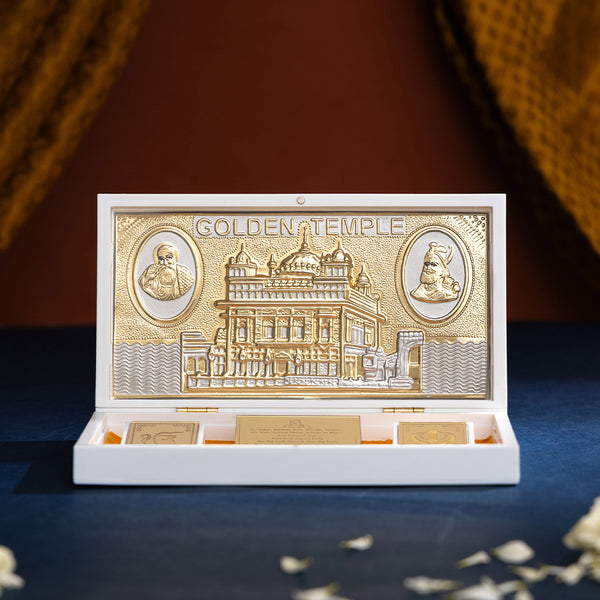An architectural marvel that has held the eyes and awe of generations across the globe, the Golden Temple in India is a majestic architectural place of worship.
Touted as one of the most religious and visited spots for cultural enrichment, the Golden Temple embraces people with its dazzling glory and quiet tranquility.
This shimmering beauty was built in Amritsar in 1574 after paying Rs. 700 for a plot of land by the great Guru Ramdas. The guru also constructed a home for himself called Guru da Chakk.
The majority of the city was built between the 17th and 18th centuries. Standing in front of the magnificent tower of gold that glitters under the sunlight, housing some of our country’s oldest cultures, revered scriptures, and once an abode to Buddha, the Golden Temple in Amritsar has it's fair share of fame and significance.
Whether you have been to the Golden Temple or haven't yet, have this beauty in your home in pocket size. The pocket Golden Temple is a realistic representation of the Golden Temple. Have the divine energy flowing through your house by placing it in your home.
This beauty is considered to be a pillar in our country’s pilgrimage sights that garners millions of visitors across the globe every year, provoking devotion and faith in our mind and body.
History of the Golden Temple

The Golden Temple was built by Guru Arjun Dev, the fifth Sikh Guru, as a place for Sikhs to gather and worship. Shri Harmandir Sahab and Sri Darbar Sahab are additional names for it.
A Muslim saint by the name of Hazrat Mian Mir Ji laid the temple's cornerstone while Guru Arjun Dev supervised its construction after Guru Ramdas purchased the land for it from the zamindars.
The top floor of this two-story temple, which is built on a 67-foot square marble slab and has about 400 kg of gold leaf, was decorated by Maharaja Ranjit Singh.
The Golden Temple is located in Amritsar. Established by Guru Ram Das who was the fourth Sikh Guru. He had initially constructed a pool there, which is encircled by other illustrious sanctuaries like the Durgiana Temple.
Scholar Valmiki is credited with writing the epic Ramayana in this region, which is also known as the Sikhism centre and where Rama and Sita's fourteen-year exile is believed to have occurred.

Svastika Golden Temple Pocket Temple - Gold Plated
Golden Temple History Related to the Mughals
On the first of Magh, 1645, Bikrmi Samvat, a Muslim saint from Lahore named Hazrat Mian Mir ji lay the foundation for Guru Arjan Sahib (December 1588).
Guru Arjan Sahib personally oversaw the construction effort, with the help of well-known Sikh figures, including Baba Budha Ji, Bhai Gurdas Ji, Bhai Sahlo Ji, and numerous other committed Sikhs.
Construction of the structure was finished in 1601 AD on Bhadoon Sudi 1st, 1661 Bikrmi Samvat (August/September 1604).
In Sri Harmandir Sahib, Guru Arjan Sahib erected the recently created Guru Granth Sahib and named Baba Budha ji as its first Granthi, or the reader of the Guru Granth Sahib.
Following this, it was given the designation "Ath Sath Tirath." The Sikh Nation now possessed it's own Tirath, a center of worship and pilgrimage.
Who Built Golden Temple?

The temple was built by Guru Arjan Dev Ji between the period 1581 and 1604. Hazrat Mian Mir, a Muslim saint laid the temple's foundation after the Guru himself designed it.
Guru Arjan Dev Ji, one of the Ten Gurus of Sikhism, was made the fifth Sikh Guru in 1581. He was regarded as the first Sikh Guru to be born into a Sikh family because he followed in the footsteps of both his father, Guru Ram Das Ji, and his successor.
"Home of the Gods" is the meaning of the word "Harmandir." The Golden Temple, also known as Shri Harmandir Sahib Ji, was constructed entirely out of pure gold foil. Everybody is welcome to visit the Golden Temple Gurudwara.
Every year, people from all over the nation travel there in the hopes that their faith will be rewarded. Every day, around 100,000 people visit this temple.
When was the Golden Temple built?
Guru Arjun constructed the Golden Temple, sometimes referred to as the Harmandir in India, in 1604.
It was reconstructed in the early 19th century using marble and copper with gold foil overlay after being repeatedly devastated by Afghan invaders.
The Gurdwara's construction was started in 1581 by Guru Arjan. The pool was kept dry and empty throughout construction.
The first Harmandir Sahib version was finished in 8 years. In order to emphasize humility and the necessity to put one's ego aside before entering the grounds to meet the Guru, Guru Arjan designed a gurdwara at a level lower than the city.
In order to stress that the gurdwara compound was accessible to everyone, he also insisted that it be open on all sides.
According to Arvind-Pal Singh Mandair, the sanctum inside the pool, where his Guru seat was located, had just one bridge to stress that the ultimate aim was just one. The brick-built gurdwara was finished in 1589.
The Architecture of the Golden Temple

The Golden Temple in Amritsar is renowned for its blend of Indo-Islamic and Hindu-Rajputan architecture.
The temple was constructed as a two-story building and is 67 feet high. It has a dome covered in gold leaf and is approximately square in shape. A marble platform measuring 19.7 x 19.7 meters square is part of the Sanctum in the Golden Temple.
This artificial pool is also known as the Amrit Sarovar. Flowers and animals are carved into the exquisite marble of the temple. Amritsar's Golden Temple has a pool that is 5.1 meters deep.
A marble passageway 3.7 meters wide and clockwise encircles it. Gold leaf and panel carvings cover the upper part of the Golden Temple, which is crowned with a 400 kg gold dome.
Priests can be seen reciting the Guru Granth Sahib throughout the day in the Golden Temple.
The Golden Temple's clock tower was not originally intended to be built. During the Second Anglo-Sikh War in 1874, the British demolished a portion of the structure and then erected a clock tower.
After 70 years, Sikhs dismantled the clock tower and replaced it with a new temple entryway. However, this gateway still goes by the name Ghanta Ghar Deori and contains a clock facing North.








